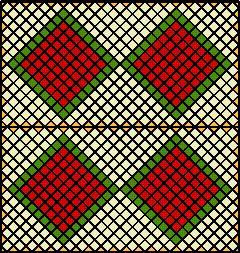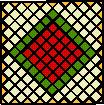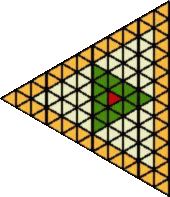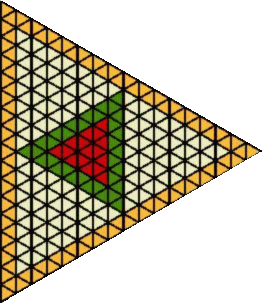Copyright © University of Cambridge. All rights reserved.
The Great Tiling Count
Floors and the ways that tiles are arranged have fascinated me for a long time. In different countries, cities and even small towns you find both walls and floors with interesting patterns.
I don't know about you but I find myself counting the tiles in particular ways. Maybe even your much younger brother or sister tends to count things that are around them. Keep your eyes open for patterns in tiles and you could discover a lot!
I was in an old church in Cambridge, where I live, and I looked at the floor.
This is what I saw:-

What a design!!
There were these things to count:-
. . . the tiles making up the three squares
. . . the dark green tiles that made a border for the squares
. . . the pale yellow tiles that filled in the gaps into the long rectangle.
When I got home I drew this design out (I had made some notes in the church, which is a good idea as it's sometimes hard to remember exactly how it was).
I then drew a 2 square version:-

and a 1 square!!

Well, it's really up to you to count and compare the numbers of particular tiles in one or all of these three designs.
See what number patterns you can come up with. I guess there are very many.
Now I wonder what would happen if we had four squares? I suppose we could put two lots of 2 together:-

I was not altogether happy with this, but maybe you are, and that's O.K.
I decided to remove that centre line and come up with:-

Mind you, you could just continue with things in a straight line. What do you think?

Try this out for yourself and maybe extend the pattern for even greater numbers of squares.
Someone might be asking "What about smaller sized squares?" You then might have something like :-

You could try some more like these.
What rules do you decide on, so that the pattern works out in the same way?
Perhaps something rather different appears with different sized squares and you could follow that line!!
And for those who really are fed up with squares why not look at the same idea with triangles!!
Yes, here we are :-

for the small one and my next size up is like this :-

But what happens when we want more of the central triangles?
I wonder??
Why do this problem?
Do this
activity to encourage pupils to look at patterns around them and find the many patterns that are usually there to discover. The Great Tiling Count can be used as a gentle introduction to investigations that bridge the spatial and the numerical aspects of mathematics. Younger children may be encouraged to
explore the situations very practically with real "tiles" of some kind, even if they are coloured cubes. Computer graphics packages will also be of use for those inclined towards using that technology.
Possible approach
If possible use this activity to actually get out and observe the patterns that are in your locality.
Using the problems as set out, there will be a need for most children to have access to squared paper and possibly triangular paper.
Some of the arithmetic that may come out of the exploration will be concerned with counting and addition as well as multiplication and the use of halves [as in the edge tiles]. Particular additions, as in the case of the first picture counting the triangular pieces, could result in discussions about adding up:-
$1 + 3 + 5 + 7 + 9$
and then when the smaller versions are considered, adding up:-
$1 + 3 + 5$
The significance of there always being four quarter pieces may be thought about.
There should be many opportunities for looking at the occurrence of even numbers ... and why?!
Key questions
What shapes can you see?
What would you like to count?
What would a larger one look like?
Possible extension
Explore mosaic and tiling patterns that can be found online. Learners can create their own mosaic/tiling patterns and be able to describe the tiles that will be necessary.
Possible support
Some pupils will need a nudge to get started on the mathematics that is associated with a pattern, also help in counting accurately where appropriate.








